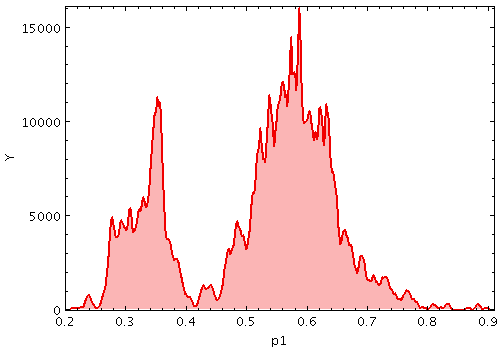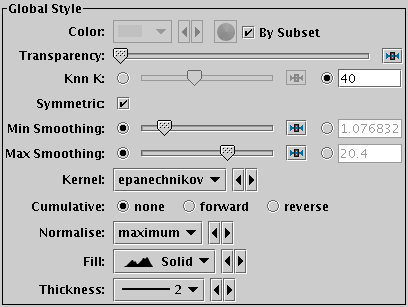Next Previous Up Contents
Next: Densogram Form
Up: Plot Forms
Previous: KDE Form
The KNN form ( )
plots a discrete Kernel Density Estimate giving a smoothed
frequency of data values along the horizontal axis, using an adaptive
(K-Nearest-Neighbours) smoothing kernel. This is a generalisation of a
histogram in which the bins are always 1 pixel wide, and a
variable-bandwidth smoothing kernel is applied to each bin
(for a fixed-bandwidth kernel, see KDE).
)
plots a discrete Kernel Density Estimate giving a smoothed
frequency of data values along the horizontal axis, using an adaptive
(K-Nearest-Neighbours) smoothing kernel. This is a generalisation of a
histogram in which the bins are always 1 pixel wide, and a
variable-bandwidth smoothing kernel is applied to each bin
(for a fixed-bandwidth kernel, see KDE).
The K-Nearest-Neighbour figure gives the number of points in each
direction to determine the width of the smoothing kernel for smoothing
each bin. Upper and lower limits for the kernel width are also supplied;
if the upper and lower limits are equal, this is equivalent to a
fixed-width kernel.
Note this is not a true Kernel Density Estimate, since, for performance
reasons, the smoothing is applied to the (pixel-width) bins rather
than to each data sample. The deviation from a true KDE caused by this
quantisation will be at the pixel level, hence in most cases not visually
apparent.
This form may be used in either the
Histogram,
Plane or
Time plot windows.

Example KNN plot

KNN form configuration panel
These options always appear in the form configuration panel:
-
Colour
- Selects the basic colour for the dataset.
-
Transparency
- Adjusts the transparency of the bars or line.
For bar styles which are already partially transparent,
this fades them further.
-
Knn K
- Sets the number of nearest neighbours to count away from a sample
point to determine the width of the smoothing kernel at that point.
For the symmetric case this is the total of nearest neighbours summed
over both directions, and for the asymmetric case it is the number in
a single direction.
The threshold is actually the weighted total of samples;
for unweighted (weight=1) bins that is equivalent to the number of samples.
-
Symmetric
- If checked, the nearest neigbour search is carried out in both
directions, and the kernel is symmetric. If unchecked, the nearest
neigbour search is carried out separately in the positive and negative
directions, and the kernel width is accordingly different in the
positive and negative directions.
-
Min Smoothing
- Fixes the minimum size of the smoothing kernel. This functions as a
lower limit on the distance that is otherwise determined by searching
for the K nearest neighbours at each sample point.
You can either use the slider, or check the radio button on the right
and enter the value in data units directly.
-
Max Smoothing
- Fixes the maximum size of the smoothing kernel. This functions as an
upper limit on the distance that is otherwise determined by searching
for the K nearest neighbours at each sample point.
You can either use the slider, or check the radio button on the right
and enter the value in data units directly.
-
Fill
- Determines how the density function is represented.
The options are:
-
solid:
area between level and axis is filled with solid colour
-
line:
level is marked by a wiggly line
-
semi:
level is marked by a wiggly line, and area below it is filled
with a transparent colour
-
Thickness
- Controls line thickness where applicable.
This is only relevant for bar styles that draw a finite thickness
line, so has no effect for solid filling.
And these options appear in the form configuration panel for the Plane window,
or the
Bins control ( )
for the Histogram window:
)
for the Histogram window:
-
Kernel
- The functional form of the smoothing kernel. The functions listed
refer to the unscaled shape; all kernels are normalised to give a
total area of unity.
The available options are:
-
square:
Uniform value: f(x)=1, |x|=0..1
-
linear:
Triangle: f(x)=1-|x|, |x|=0..1
-
epanechnikov:
Parabola: f(x)=1-x*x, |x|=0..1
-
cos:
Cosine: f(x)=cos(x*pi/2), |x|=0..1
-
cos2:
Cosine squared: f(x)=cos^2(x*pi/2), |x|=0..1
-
gauss3: Gaussian truncated at 3.0 sigma:
f(x)=exp(-x*x/2), |x|=0..3
-
gauss6: Gaussian truncated at 6.0 sigma:
f(x)=exp(-x*x/2), |x|=0..6
-
Cumulative
- If set to forward or reverse,
the heights are plotted cumulatively;
each bin includes the counts from all previous bins in the
direction of negative or positive infinity.
-
Normalise
- Defines how, if at all, the bars are normalised.
The available options are:
-
none:
No normalisation is performed.
-
area:
The total area of histogram bars is normalised to unity.
For cumulative plots, this behaves like height.
-
unit:
Histogram bars are scaled by the inverse of the bin width in data units.
For cumulative plots, this behaves like none.
-
maximum:
The height of the tallest histogram bar is normalised to unity.
For cumulative plots, this behaves like height.
-
height:
The total height of histogram bars is normalised to unity.
When used in the Time plot only,
additional options per_second, per_day etc
are available corresponding to the frequency over the named time unit.
Next Previous Up Contents
Next: Densogram Form
Up: Plot Forms
Previous: KDE Form
TOPCAT - Tool for OPerations on Catalogues And Tables
Starlink User Note253
TOPCAT web page:
http://www.starlink.ac.uk/topcat/
Author email:
m.b.taylor@bristol.ac.uk
Mailing list:
topcat-user@jiscmail.ac.uk
![]() )
plots a discrete Kernel Density Estimate giving a smoothed
frequency of data values along the horizontal axis, using an adaptive
(K-Nearest-Neighbours) smoothing kernel. This is a generalisation of a
histogram in which the bins are always 1 pixel wide, and a
variable-bandwidth smoothing kernel is applied to each bin
(for a fixed-bandwidth kernel, see KDE).
)
plots a discrete Kernel Density Estimate giving a smoothed
frequency of data values along the horizontal axis, using an adaptive
(K-Nearest-Neighbours) smoothing kernel. This is a generalisation of a
histogram in which the bins are always 1 pixel wide, and a
variable-bandwidth smoothing kernel is applied to each bin
(for a fixed-bandwidth kernel, see KDE).

